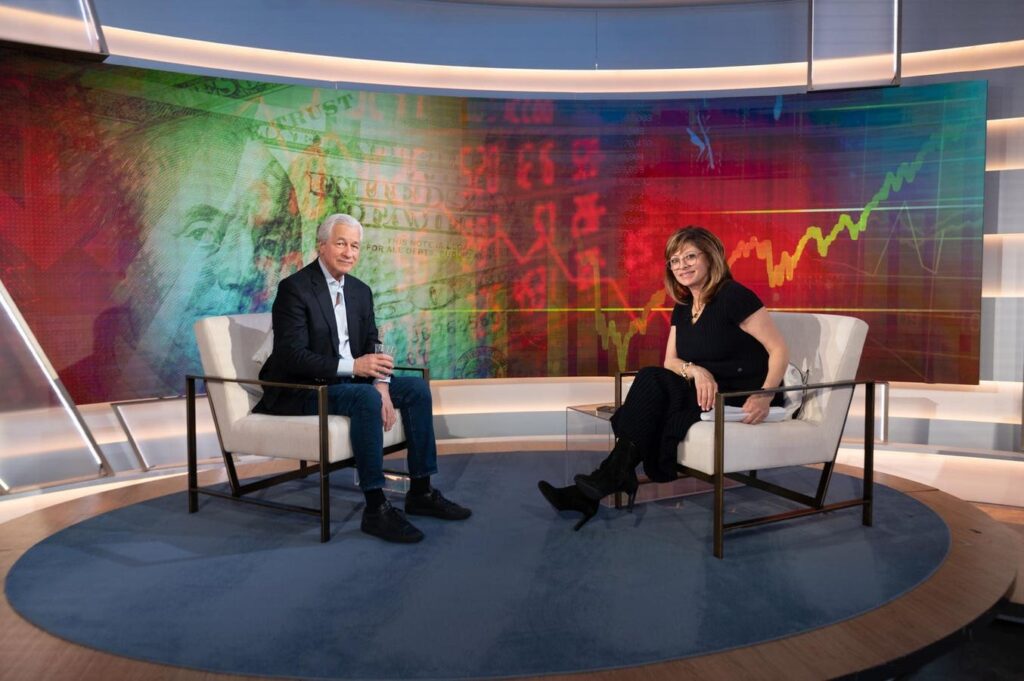“Most CEOs I talk to would say we are probably in a recession right now,” Blackrock CEO Larry Fink explained at an event for the Economic Club of New York on April 7.
“I think probably [a recession is]
a likely outcome, because markets, I mean, when you see a 2000-point decline [in the Dow Jones Industrial Average], it sort of feeds on itself, doesn’t it,” Jamie Dimon said on Fox Business’ “Mornings With Maria” show on April 9. “It makes you feel like you’re losing money in your 401(k), you’re losing money in your pension. You’ve got to cut back.”
The JPMorgan Chase CEO added, “Markets aren’t always right, but sometimes they are right. I think this time they are right because they’re just pricing uncertainty [at] the macro level and uncertainty [at] the micro level, at the actual company level, and then how it affects consumer sentiment. It’s hard to tell.”
If it Quacks Like a Duck
Goldman Sachs on April 6 raised its probability of a U.S. economic contraction in the next 12 months to 45%, up from 35%, as its economists cited policy uncertainty, foreign consumer boycotts and tighter financial conditions.
Goldman’s odds surged to 65% on the morning of April 9, but the investment bank quickly revised that estimate back down to 45% after President Trump shocked the markets with a post on Truth Social:
Based on the fact that more than 75 Countries have called Representatives of the United States, including the Departments of Commerce, Treasury, and the USTR, to negotiate a solution to the subjects being discussed relative to Trade, Trade Barriers, Tariffs, Currency Manipulation, and Non Monetary Tariffs, and that these Countries have not, at my strong suggestion, retaliated in any way, shape, or form against the United States, I have authorized a 90 day PAUSE, and a substantially lowered Reciprocal Tariff during this period, of 10%, also effective immediately.
Needless to say, economic forecasting is fraught with peril!
Don’t Believe Everything You Read
Given that the tariff battle is far from over and President Trump also amped the levies on China on April 9, the odds of recession remain elevated. As a result, I continue to expect a steady stream of headlines warning that a slowdown in economic activity will drag down corporate profits and, in turn, stock prices.
That seems logical in theory, but we think it important to investigate what has happened in practice. There have “only” been 15 economic recessions in the United States since 1927, which is how far back freely available equity return data exists. While the 16th may be imminent, the start and end dates are never known in advance. And contrary to current media proclamations, stocks have suffered only modest pullbacks, on average, during contractions and decent gains, again on average, in the year leading up to them.
More importantly, investors in Value, Dividend, Large and Small Stocks have enjoyed fantastic average returns following the end of an economic contraction. Alas, they don’t ring a bell to mark the conclusion. As a result, those who somehow managed to avoid historically modest average losses during a recession likely sat on the sidelines waiting for an all-clear signal and missing a large part of the massive rallies.
Irrespective of the giant near-3000-point rebound in the Dow Jones Industrial Average on April 9, I continue to think trying to outguess the economy is hardly a recipe for success. Yes, it would be nice to be find a reliable indicator that tells an investor when to get in and out of stocks, but I learned long ago that the only problem with market timing is getting the timing right.
Corroborating the Facts
Russell Investments has done its own study of recessions and stocks going back further in time than mine.
They have found: “The 15 recessions with negative returns lasted 17 months on average, with an annualized cumulative return of -14.8% and average GDP decline of -4.6%. The Great Depression from August 1929 through March 1933, a duration of 43 months, had a total U.S. stock return of -73.6% and was the worst economic downturn on record.”
Of course, they have also learned: “There have been 16 recessions which had positive stock market returns—as measured from the start to the end of each recession. These positive-market recessions lasted on average 16 months, with stock returns ranging from 38.1% to 0.02%, with an annualized cumulative return of +9.8% and an average GDP decline of -2.7%.”
Now all we need to know is if the next recession will see stocks have negative or positive returns and we will be set, though if a contraction began at the start of this month as Mr. Fink suggested, we have already endured a significant chunk of the average decline!
*****
For those who like what I have to say in this forum, further market analytics and stock picks can be found in my newsletter, The Prudent Speculator.
Disclosure: Please note that shares of the stocks mentioned are owned by asset management clients of Kovitz Investment Group Partners, LLC, a SEC registered investment adviser. For a list of stock recommendations like these made in The Prudent Speculator, visit theprudentspeculator.com.
Read the full article here


